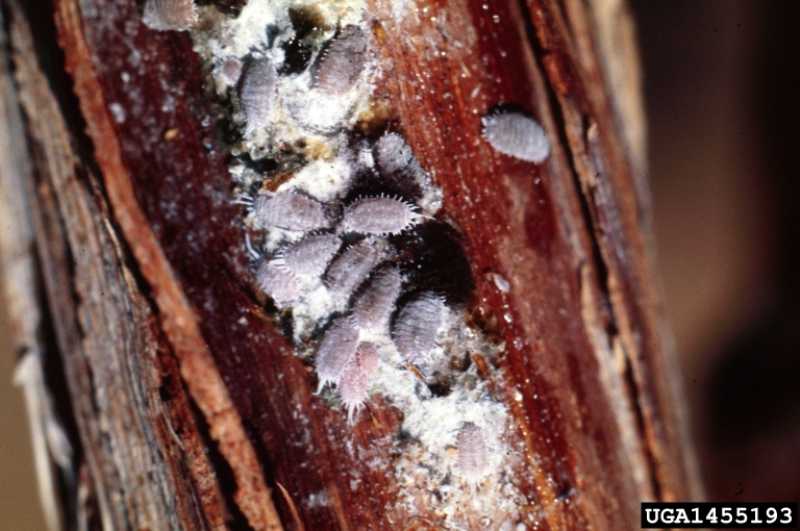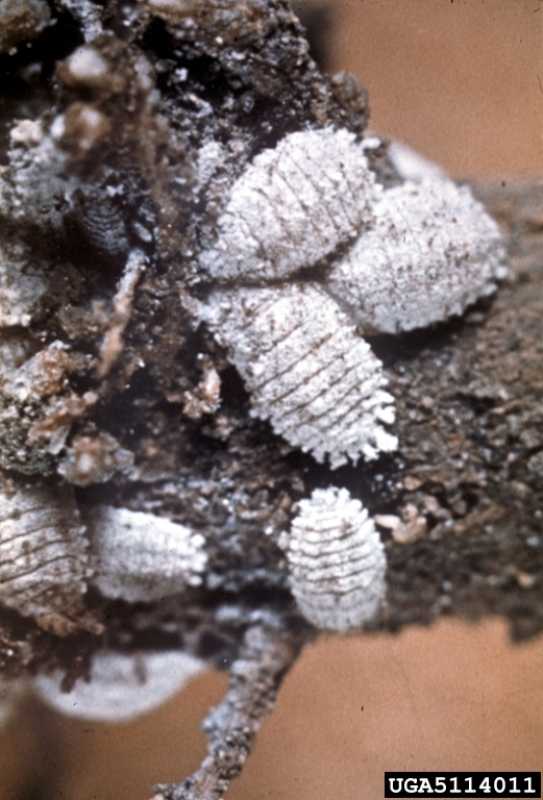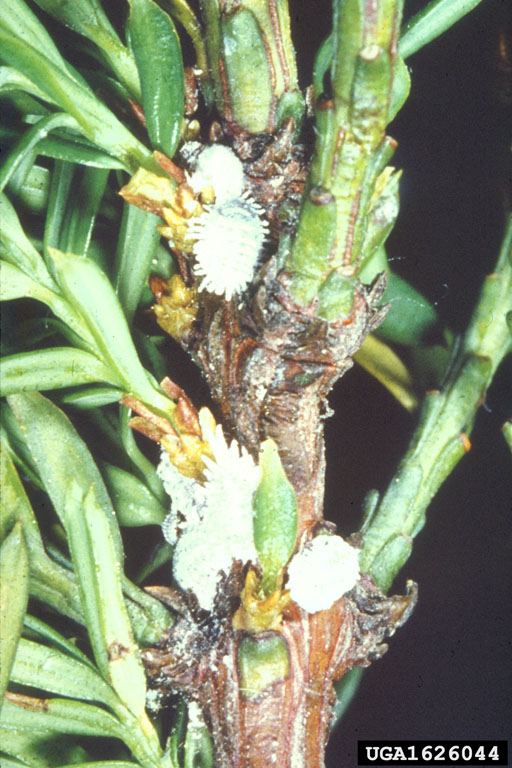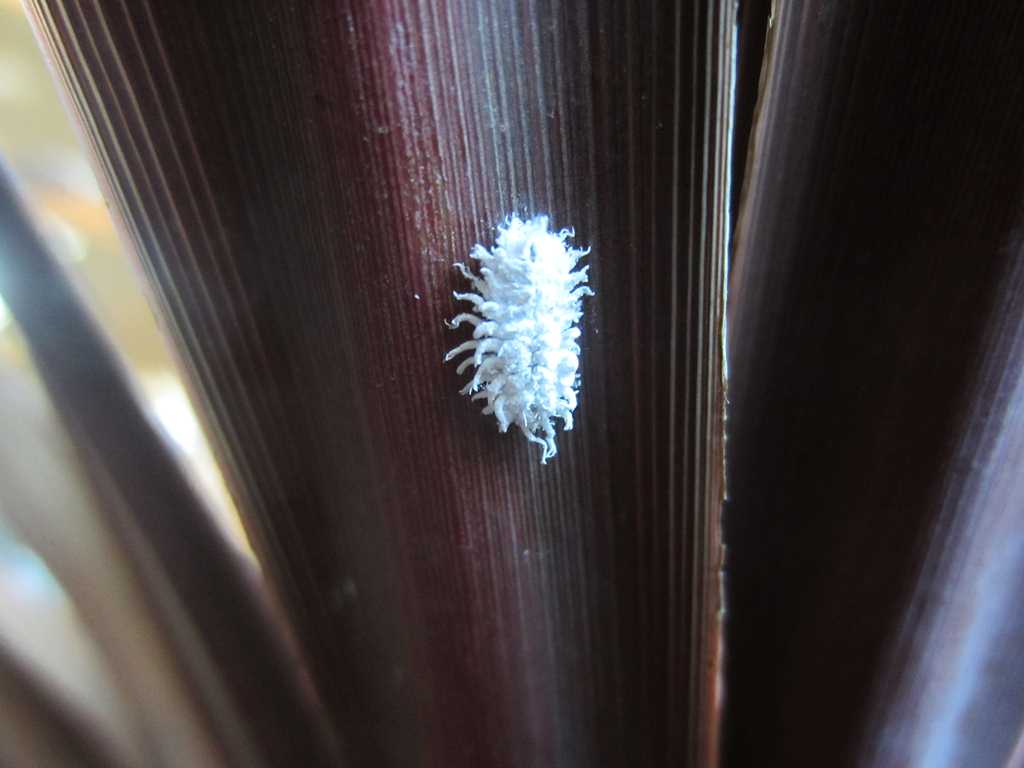 |
Grape vine (Vitis) infested with mealybugs (Hemiptera). W. Cranshaw, CSU, Bugwood.org |
Mealybugs get their common name from white waxy secretions that cover their bodies. They are in the order Homoptera, which includes scales, whiteflies, and aphids, some species of which also cover their bodies with white waxy secretions, making field identification confusing. In warmer climates, mealybugs are serious pests on many citrus and ornamental plants. In this area, a wide variety of indoor and tropical plants summered outdoors or maintained in greenhouses can be attacked, as can many outdoor woody trees and shrubs, perennials, and summer annuals (e.g. begonia and coleus).
Some mealybug species can overwinter as nymphs and eggs. However, outside resurgences in the spring often come from introduction of mealybuginfested plants, with young nymphs from the infested plant colonizing nearby plants. Ants may also transport mealybugs from one plant to another.
Symptoms and Diagnosis
The typical female mealybug is 1/16 to 1/8 inch long with a white, waxy, oval body and functional legs. Some species are up to1/4 inch long. Males are much smaller, usually winged, and seldom seen.
Mealybugs infest all plant parts; feeder roots, root crowns, stems, twigs, leaves, flowers, and fruit. Here, mealybug infestations usually involve leaves (mostly undersides), stems, branches, and joints. They pierce and suck sap, excreting a sticky honeydew over leaves and stems that provides an excellent growth medium for a sooty-colored mold, giving the plant a dirty, sooty appearance. Ants are likely to be found feeding on the honeydew.
Heavily infested plants will experience irregular or no growth, yellowed leaves, and significant leaf drop. Left untreated, plants can die.
Life Cycle
Most species are egg layers, though some, especially under greenhouse-like conditions, give live birth. Normally, females lay about 500 eggs in a cottony mass. Hatching in 1 to 2 weeks, nymphs resemble adult females, but male and females then develop differently. Female nymphs increase in size with each molt, reaching adulthood in about a month. In contrast, male mealybugs go through two or so molts and then enter a pupal state in a flimsy cocoon before hatching as a tiny, fly-like, twowinged adult, incapable of feeding and soon to die.
Outdoors, two generations a year are common. Eight generations a year are possible in optimal greenhouse-like conditions. Several developmental stages can usually be found simultaneously.
Integrated Pest Management Strategies
1. Prevent new infestations. Examine, quarantine for 2 or 3 weeks, and treat as necessary (see below) all new plants before placing them near mealybug-free plants. Examine all plants frequently for pests.
2. Conserve natural enemies. Predatory insects, such as lacewings, syrphid flies, ladybugs, and several small parasitic wasps, prey on outdoor mealybugs and can often keep their population within bounds. An introduced beetle, Cryptolaemus montrouzieri, the mealybug destroyer, is available commercially for release in greenhouses. Avoid unnecessary insecticide use to minimize damage to these beneficial insects.
3. Remove mealybugs manually. Depending on host plant size and scope of infestation, remove mealybugs with alcohol-dipped cotton swabs or physically knock them off plants with a forceful water spray and repeat as necessary. While unlikely to eliminate mealybugs, this approach can often keep the infestation within tolerable limits and will have no negative impact on beneficial insects.
4. Control ants. Ants are known to transport mealybugs from one plant to another, so physical barriers or chemical controls that do not adversely impact beneficial insects can be part of a prevention and control program.
5. Use insecticidal soap or superior horticulture oil sprays. If above methods fail to reduce mealybug populations to acceptable levels, use insecticidal soap sprays or superior horticultural oil spray following label directions carefully to avoid damage to sensitive plants and beneficial insects. If possible, treat when crawlers are present. Mealybugs hide under leaves and in crotches, so be sure spraying is thorough. Repeat application as necessary in accordance with label instructions.
6. Use chemical insecticides. Acephate (Orthene), bifenthrin, and pyrethrins are effective against mealybugs. Follow label directions carefully.
Organic Strategies
Strategies 1, 2, and 3 are strictly organic approaches. For an organic approach to Strategy 4, control ants using an organic method. For an organic approach to Strategies 5 and 6, consult the Organic Materials Review Institute (OMRI™) for appropriate insecticidal soap and pyrethrin products.
More images:
 |
| Crabapple/apple (Malus) infested with mealybugs (Hemiptera). W. M. Ciesia, Forest Health Mgmt International, Bugwood.org |
|
 |
| Mealybugs (Hemiptera) on aster (Aster). R. Gill, CDFA, Bugwood.org |
|
 |
Mealybug adults (Hemiptera0 on yew (Taxus). J.A. Weidhass, VPISU, Bugwood.org
|
|

|
Mealybug destroyer (Coleoptera) on cordyline. As the name implies these eat mealybugs (Hemiptera) and other soft bodied insects; adult is a lady beetle.
|
|